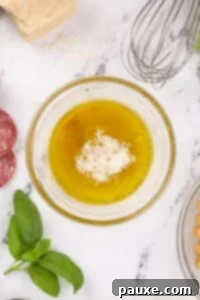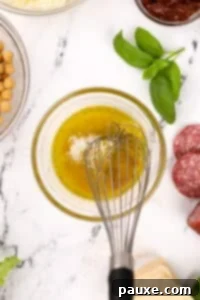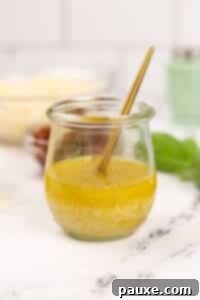Mastering Leon Salad Dressing: The Iconic La Scala Vinaigrette Recipe at Home
Step into the world of classic Californian cuisine with the legendary Leon Salad Dressing, famously known as the La Scala Dressing. This iconic vinaigrette, a unique blend of robust olive oil, crisp white wine vinegar, a touch of mustard powder, and savory Parmesan cheese, has captivated palates for decades. Originating from the renowned La Scala Beverly Hills restaurant, it’s more than just a dressing; it’s a culinary legacy.
Whether you’re pouring it over a bed of fresh, crisp lettuce, tossing it into your favorite pasta salad, or using it to elevate a simple grilled chicken, this homemade dressing promises a burst of sophisticated flavor. Forget bland store-bought options; discover how easy it is to create this restaurant-quality vinaigrette in your own kitchen.
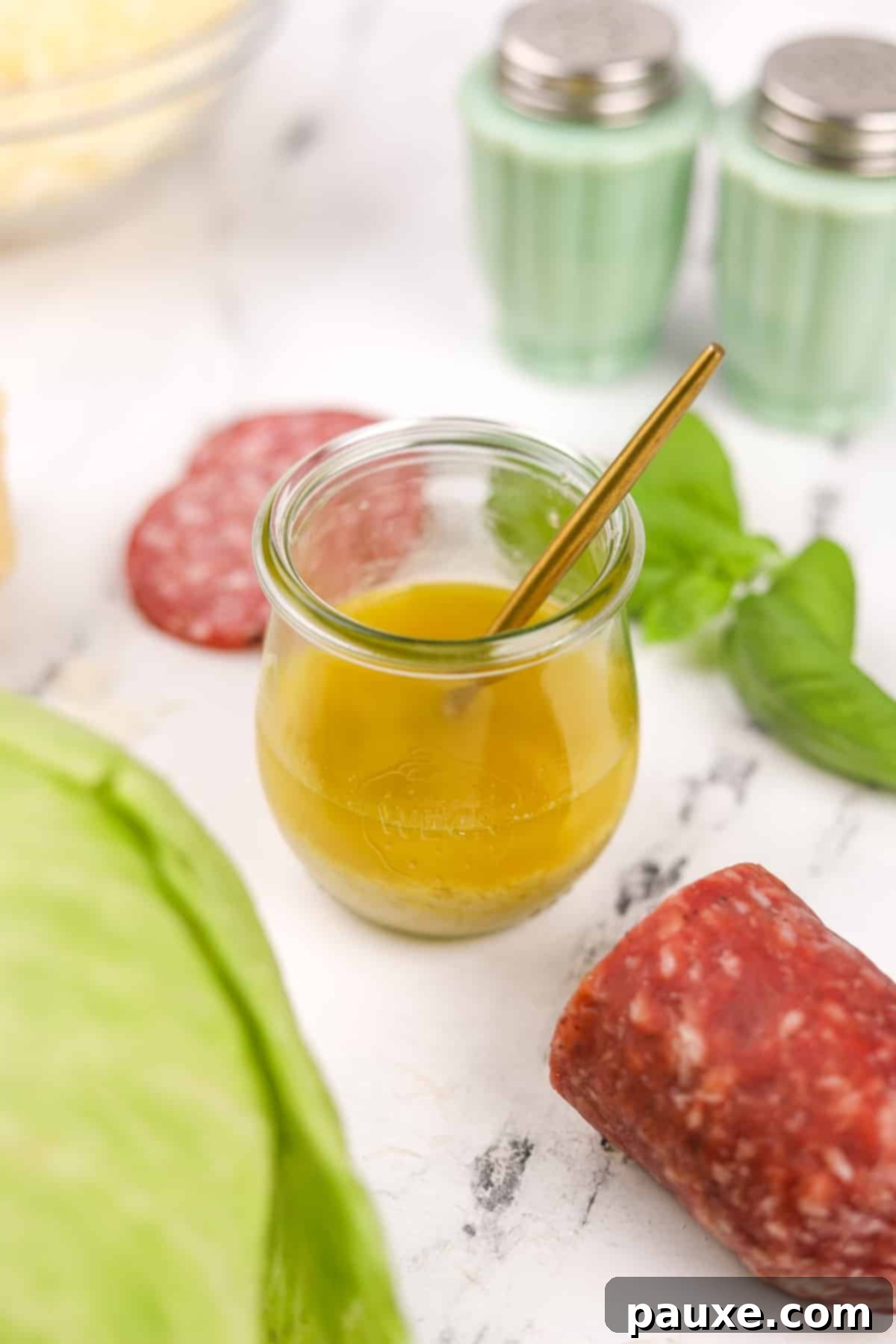
Table of Contents
- What is Leon Salad Dressing?
- The Legacy of La Scala & Chef Jean Leon
- Why Make Your Own Salad Dressing?
- Essential Ingredients for Leon Dressing
- Step-by-Step Instructions for Homemade La Scala Dressing
- Versatile Ways to Use Your Leon Dressing
- Storing Your Homemade Dressing for Freshness
- Substitutions and Creative Variations
- Top Tip for a Perfect Vinaigrette
- Leon Salad Dressing (Famous La Scala Recipe)
My journey to discovering this incredible dressing began with the viral sensation of the famous La Scala Chopped Salad. While delving into its components, I stumbled upon a consistent mention of “Leon Dressing” on the La Scala menu. Intrigued by a dressing I hadn’t encountered before, I immediately set out to uncover its secrets and recreate this legendary flavor at home.
What is Leon Salad Dressing?
At its core, Leon dressing is a vibrant vinaigrette, distinguished by its unique blend of traditional and unexpected elements. Unlike many classic vinaigrettes that rely on Dijon or prepared mustard, this recipe boldly incorporates mustard powder, lending a distinct, nuanced pungency and aiding in the dressing’s silky emulsification. Combined with high-quality olive oil, the bright tang of white wine vinegar, and the rich, nutty notes of Parmesan cheese, it creates a perfectly balanced and incredibly flavorful concoction.
This dressing is more than just a condiment; it’s a taste of culinary history, reflecting the sophisticated yet approachable style that made La Scala restaurant a Hollywood favorite.
The Legacy of La Scala & Chef Jean Leon
The iconic Leon dressing was meticulously crafted by the visionary Chef Jean Leon for the celebrated La Scala restaurant in Beverly Hills. Dating back to the vibrant culinary scene of the 1950s, this dressing was specifically developed to complement La Scala’s exquisite salads, most notably their world-renowned La Scala Chopped Salad.
Chef Leon’s creation became synonymous with the restaurant’s commitment to fresh, high-quality ingredients and timeless Italian-American flavors. Its enduring popularity is a testament to its perfectly balanced profile – a delightful harmony of acidity, richness, and savory depth that truly enhances, rather than overwhelms, the ingredients it dresses. Understanding its origin adds another layer of appreciation to this simple yet profound culinary masterpiece.
Why Make Your Own Salad Dressing?
In a world overflowing with store-bought options, you might wonder why bother making salad dressing from scratch. The answer lies in freshness, flavor, and control. Homemade Leon Salad Dressing offers an unparalleled taste experience that simply cannot be replicated by commercial products. Here’s why making your own is always the best choice:
- Unrivaled Freshness: Store-bought dressings often sit on shelves for months. A homemade dressing, prepared minutes before serving, bursts with fresh, vibrant flavors that elevate your entire meal.
- Control Over Ingredients: You dictate what goes into your dressing. This means no artificial preservatives, unhealthy oils, excessive sugars, or unnecessary additives. It’s a healthier, cleaner option for you and your family.
- Customization to Your Palate: Love a bit more tang? Add extra vinegar. Prefer a richer dressing? Adjust the olive oil. Making it yourself allows you to fine-tune the flavors to perfectly match your taste preferences.
- Cost-Effective: Basic pantry staples are all you need for this Leon dressing recipe, making it a much more economical choice than repeatedly buying premium store-bought versions.
- Impress Your Guests: There’s a certain satisfaction in serving something made from scratch. Your guests will undoubtedly appreciate the effort and the superior taste of your homemade vinaigrette.
Essential Ingredients for Authentic Leon Dressing
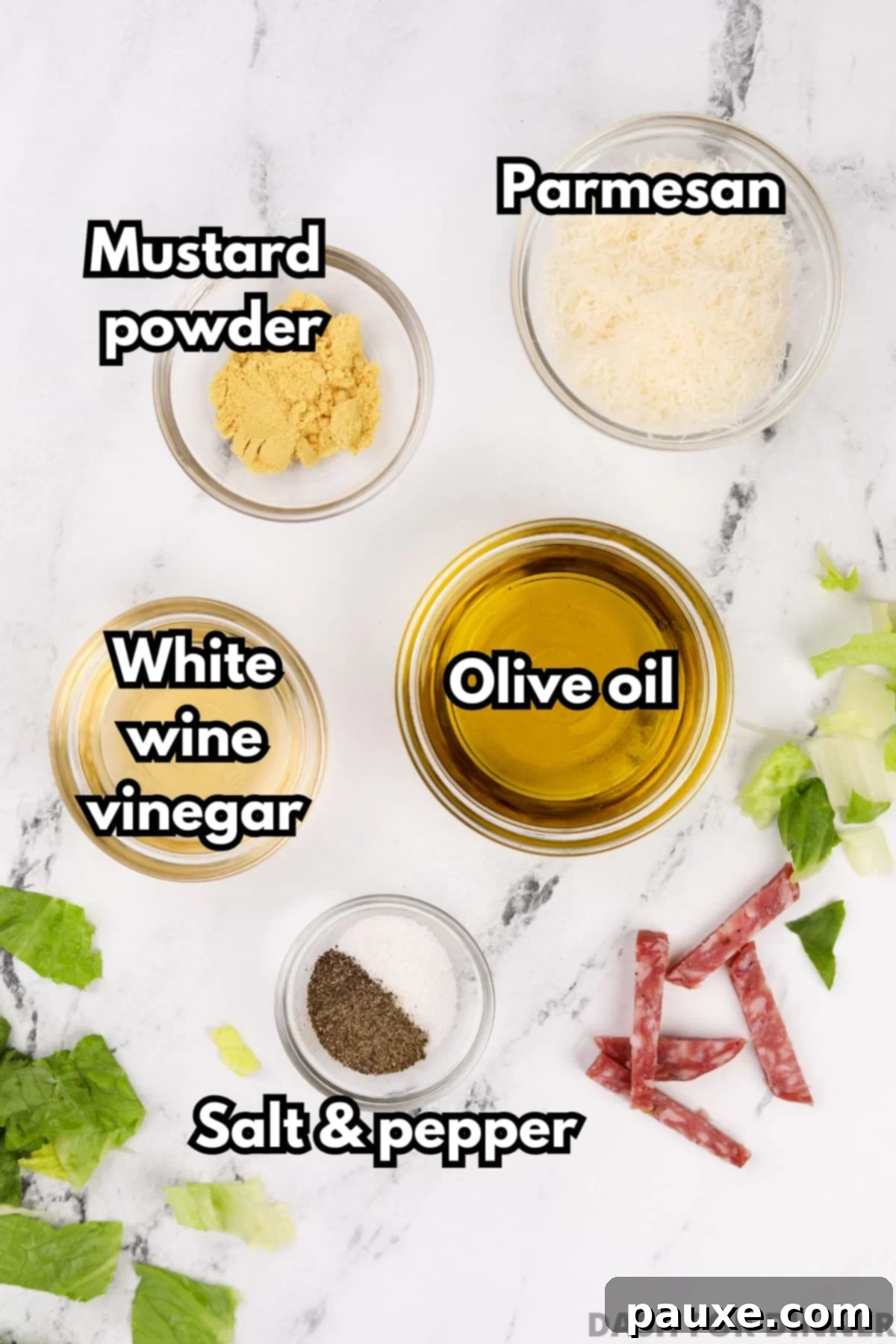
Creating the perfect Leon Salad Dressing relies on a few high-quality, simple ingredients. Each component plays a crucial role in building the dressing’s distinctive flavor profile and texture:
- Extra Virgin Olive Oil: The foundation of any good vinaigrette. Using a high-quality extra virgin olive oil (EVOO) is paramount for the best flavor and a smooth, luxurious texture. Its fruity, peppery notes are a key part of the dressing’s character. Choose a cold-pressed, quality olive oil for optimal results.
- White Wine Vinegar: This provides the essential acidic component, offering a delicate tang that brightens the entire dressing. White wine vinegar is chosen for its subtle, less assertive flavor compared to red wine or distilled vinegars, allowing the other ingredients to shine. It creates a beautiful balance against the richness of the oil and cheese.
- Mustard Powder: Also known as dry mustard or ground mustard, this ingredient is the unique secret behind Leon dressing. Found in the spice aisle, it contributes a sharp, pungent flavor that’s distinct from prepared mustards. Crucially, mustard powder acts as an excellent emulsifier, helping the oil and vinegar bind together into a stable, creamy vinaigrette. While you can substitute Dijon mustard in a pinch, the dry powder provides an unmatched authenticity.
- Parmesan Cheese: Finely grated Parmigiano Reggiano is a non-negotiable for its delicious savory, salty, and nutty flavor, adding a layer of umami complexity. The fine grate ensures it disperses evenly throughout the dressing, contributing to its texture without clumping. Always opt for fresh Parmesan over pre-grated for superior taste and texture.
- Salt and Freshly Ground Black Pepper: These fundamental seasonings are vital for enhancing and balancing all the other flavors. I prefer using a fine-ground salt for easier dissolving and even distribution, rather than coarser kosher salt. Freshly ground black pepper adds a fragrant, subtle heat that complements the overall profile.
For precise measurements, please refer to the detailed recipe card below.
Step-by-Step Instructions for Homemade La Scala Dressing
Making this incredible Leon Salad Dressing is remarkably simple, requiring minimal effort for maximum flavor payoff. Follow these easy steps to whip up your own batch:
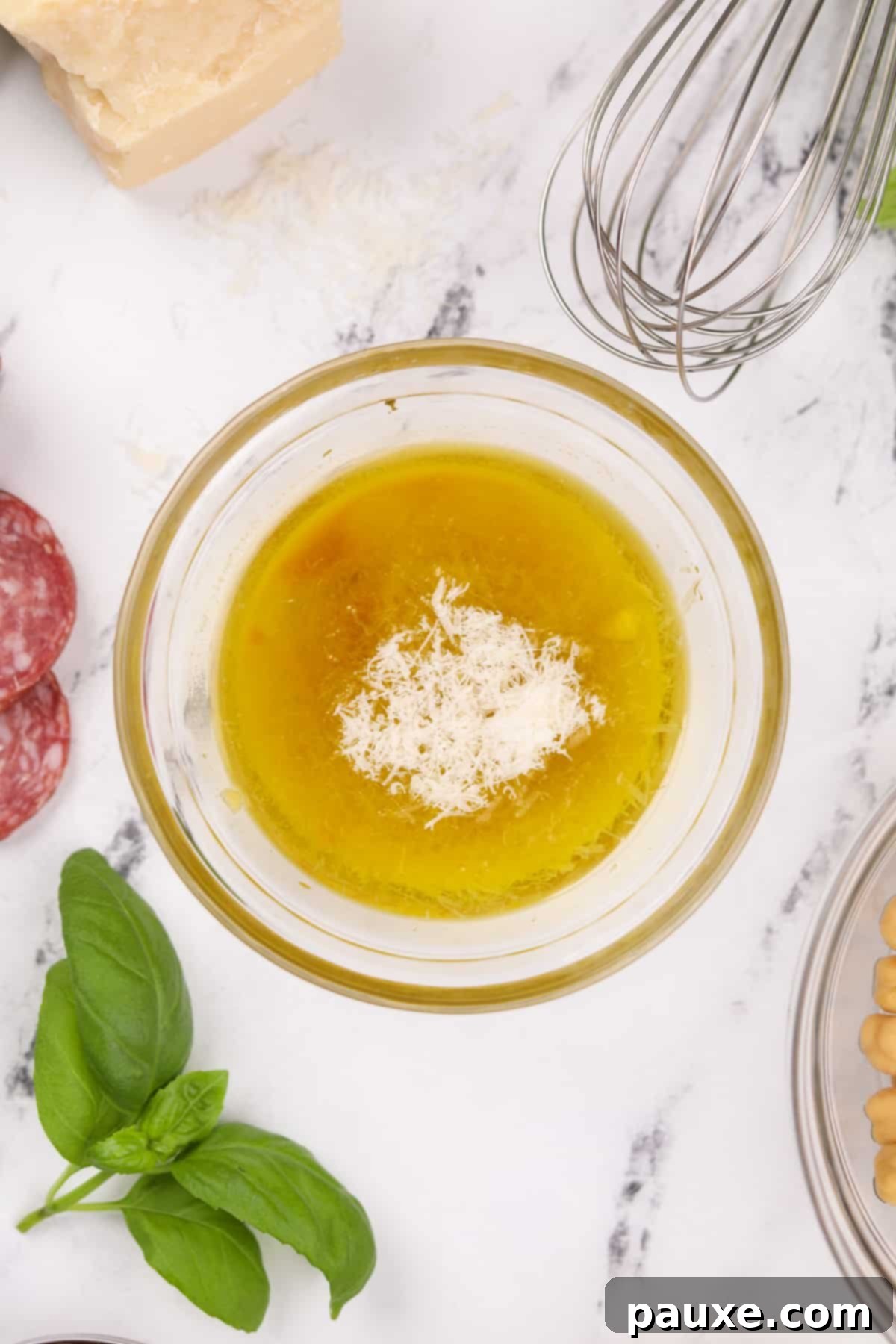

Step One: Combine Ingredients. Add the precise amounts of extra virgin olive oil, mustard powder, white wine vinegar, salt, freshly ground black pepper, and finely grated Parmesan cheese into a small mixing bowl. Alternatively, for even easier preparation and storage, you can use a glass mason jar with a secure lid.
Step Two: Emulsify Thoroughly. If using a bowl, whisk all the ingredients together vigorously for at least 30-60 seconds. The goal is to create a smooth, homogenous mixture where the oil and vinegar are fully emulsified. If using a mason jar or cruet, seal the lid tightly and shake vigorously until well combined and creamy. Proper emulsification is key to the dressing’s texture and flavor.

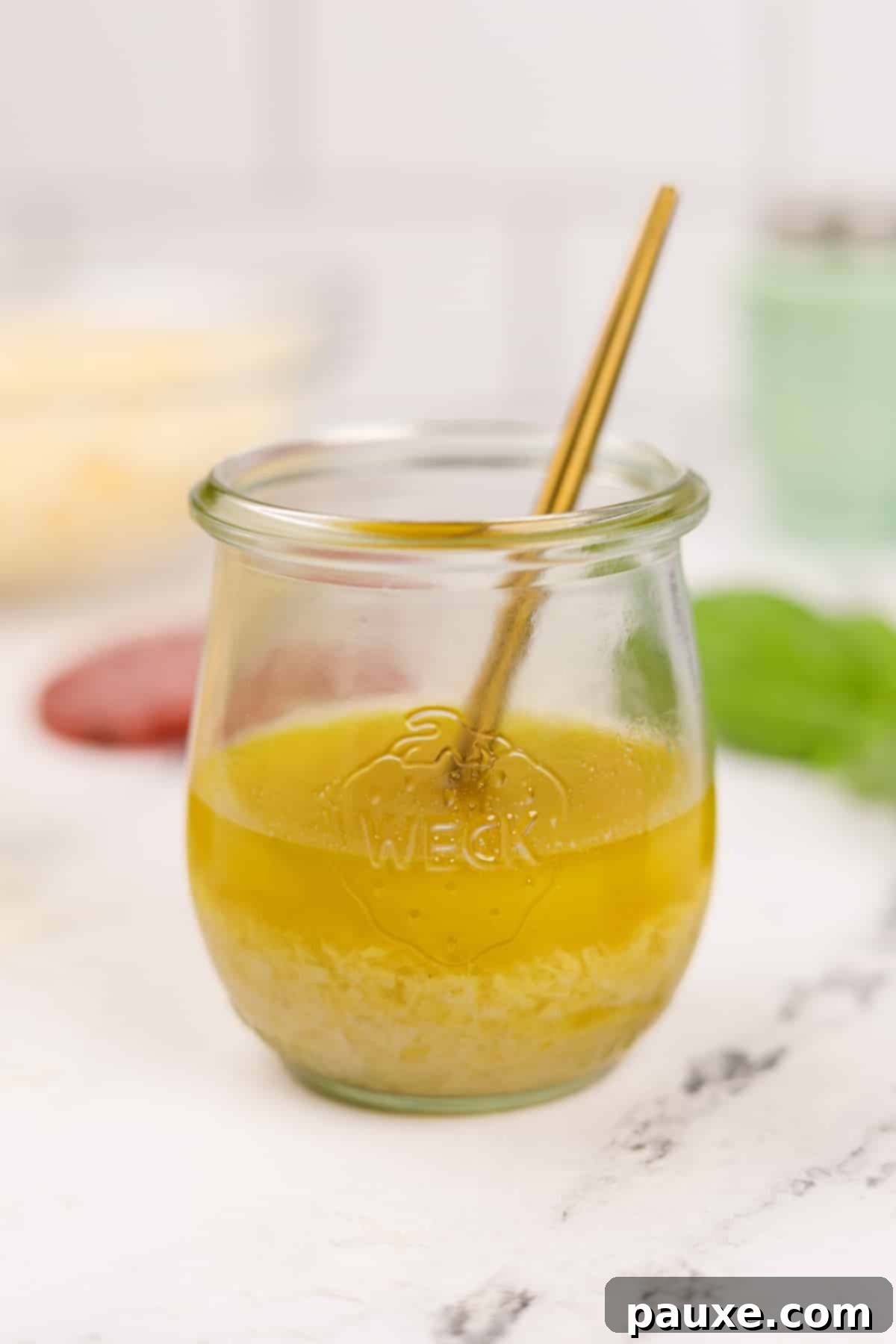
Step Three: Serve and Enjoy. Once your dressing is beautifully combined and emulsified, it’s immediately ready to serve. Drizzle it generously over a simple green salad, or explore more adventurous pairings with your chosen ingredients. A quick taste test before serving allows you to make any final adjustments to seasoning.
Step Four: Store for Later. If you’re not using all of the dressing immediately, transfer it into a pourable container, such as a salad cruet or a clean bottle with a tight stopper, for easy storage and future use. This ensures convenience and keeps your dressing fresh for longer.
Versatile Ways to Use Your Leon Dressing
The beauty of Leon Salad Dressing lies in its incredible versatility. While it’s famously associated with the La Scala Chopped Salad, its balanced flavor profile makes it suitable for a multitude of culinary applications. Here are some fantastic ways to enjoy your homemade dressing:
- La Scala Chopped Salad: The classic pairing! This salad typically features crunchy garbanzo beans, fresh mozzarella cheese, and savory sliced salami, all brought together by the vibrant Leon dressing.
- Simple Green Salads: Elevate any basic salad with mixed greens, arugula, or spinach. The dressing’s rich yet bright profile transforms even the simplest salad into a gourmet experience.
- Arugula Salad: The peppery notes of arugula are beautifully complemented by the dressing’s tang and richness, creating a wonderfully balanced bite.
- Quinoa or Grain Salads: Add a burst of flavor to your healthy grain bowls or salads. It pairs exceptionally well with cooked quinoa, farro, or couscous, especially when combined with fresh vegetables and herbs.
- As a Marinade for Chicken or Fish: The acidity of the vinegar and the richness of the oil make it an excellent tenderizer and flavor infuser for lean proteins like chicken breasts, fish fillets, or even firm tofu before grilling, baking, or pan-searing.
- Pasta Salad: Forget heavy, creamy pasta salads. This vinaigrette offers a lighter, more refreshing alternative that coats pasta beautifully, especially when mixed with cherry tomatoes, fresh basil, and olives.
- Roasted Vegetables: Drizzle over roasted asparagus, broccoli, or bell peppers for a tangy finish that enhances their natural sweetness.
- Bread Dipping Oil: Serve it alongside crusty artisan bread for a delightful appetizer.
- Sandwich or Wrap Spread: A thin layer inside a sandwich or wrap can add a sophisticated touch of flavor.

Storing Your Homemade Dressing for Freshness
One of the many advantages of homemade dressings is their fresh quality, but proper storage is key to maintaining it. For your Leon Salad Dressing, here’s how to ensure it stays delicious:
Keep any leftover dressing in an airtight container or a glass jar with a tightly fitting lid. Stored correctly in the refrigerator, your homemade vinaigrette will remain fresh and flavorful for up to 2 weeks.
It’s important to note that the olive oil component in the dressing will naturally solidify and become cloudy when chilled. This is a normal characteristic of high-quality olive oil and does not indicate spoilage. To restore the dressing to its perfectly pourable consistency, simply:
- Allow it to rest: Remove the dressing from the refrigerator 10-30 minutes before you plan to use it. Letting it sit at room temperature will allow the olive oil to soften and return to its liquid state.
- Warm water trick: If you’re short on time, you can run warm (not hot) water over the outside of the jar or container for a few minutes. Gently shake the dressing once the oil has visibly softened.
Always give the dressing a good shake or whisk before serving, as the ingredients may naturally separate slightly during storage.
Substitutions and Creative Variations
While the original Leon dressing recipe is a timeless classic, don’t hesitate to experiment with substitutions or add your own twist. Here are some ideas to adapt the recipe to your pantry or personal preference:
- Dijon Mustard: If you don’t have mustard powder on hand, you can certainly swap it for Dijon mustard. Use a similar amount, keeping in mind that Dijon will add a bit more liquid and a slightly different, smoother mustard flavor.
- Red Wine Vinegar: For a deeper, more robust flavor profile, red wine vinegar works as a decent substitute for white wine vinegar. Be aware that it has a stronger, fruitier taste, so you might start with a slightly lesser amount and adjust to your liking.
- Fresh Lemon Juice: If wine vinegar isn’t available, freshly squeezed lemon juice makes a bright and zesty alternative. This will result in more of a classic lemon vinaigrette, offering a delightful citrusy kick. For an extra burst of aroma, consider adding a pinch of lemon zest.
- Avocado Oil: While extra virgin olive oil is highly recommended for its flavor, avocado oil can be used as a neutral alternative if you prefer. It will result in a milder dressing, as avocado oil has a less pronounced taste.
- Parmesan Cheese Alternatives: Other hard, aged cheeses like Pecorino Romano or Grana Padano can make good substitutes for Parmesan. They offer similar salty and savory notes. Just ensure they are very finely grated before adding them to the dressing.
- Garlic: For garlic lovers, finely minced fresh garlic (about ½-1 clove) can be added to the dressing for an aromatic punch.
- Shallots: A tablespoon of finely minced shallots can add a delicate oniony flavor and a subtle sweetness.
- Herbs: Incorporate dried Italian herbs like oregano or basil for an added layer of classic Mediterranean flavor.
- Sweetener: For those who prefer a touch of sweetness in their vinaigrette, a small amount of honey or maple syrup can be whisked in.
Top Tip for a Perfect Vinaigrette
For a beautifully balanced dressing, always taste and adjust seasonings. A pinch more salt can bring out all the flavors, and a touch more vinegar can brighten it up. Don’t be afraid to customize it to your personal preference!
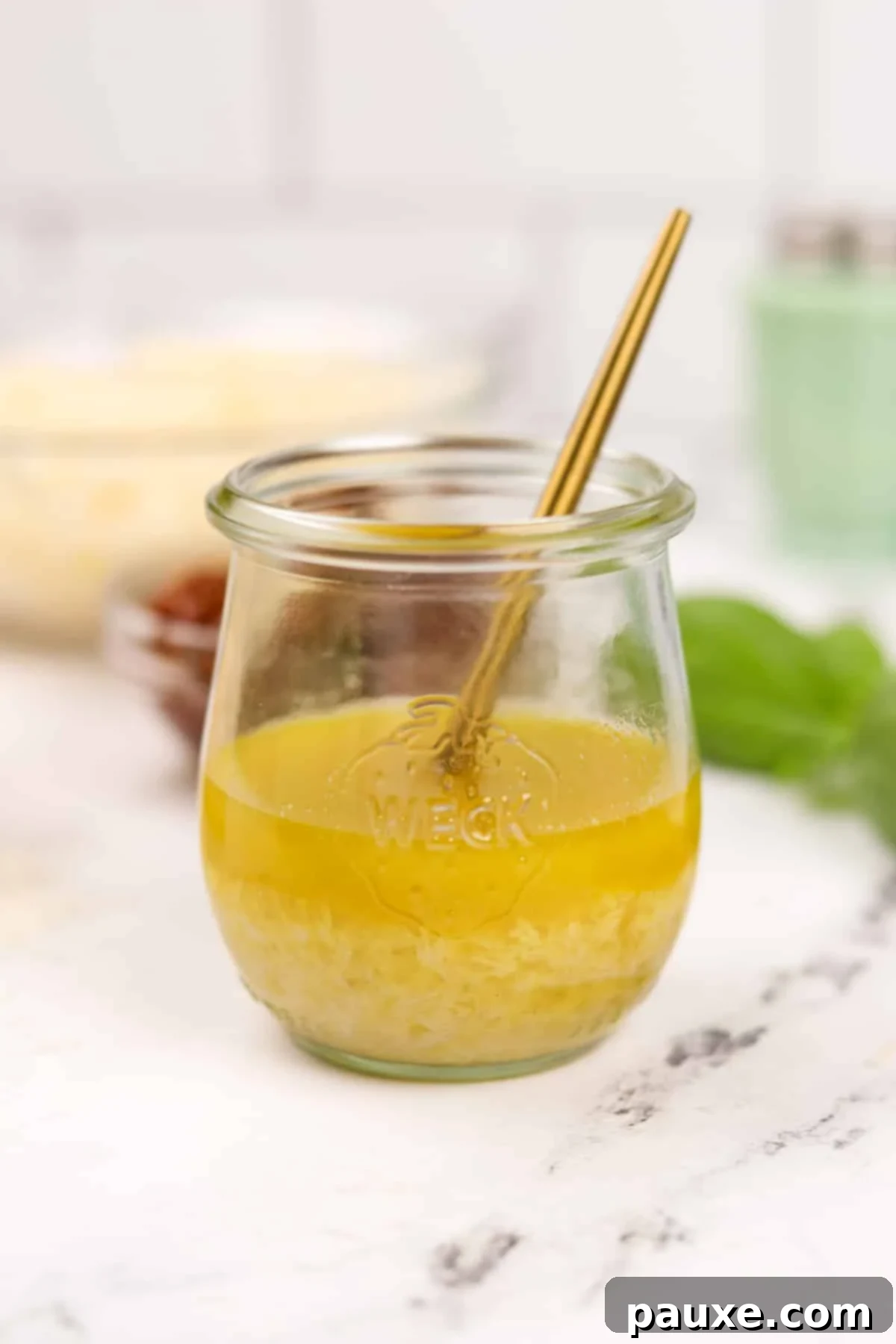
Embrace the art of homemade salad dressing and bring the legendary flavors of La Scala to your table with this authentic Leon Salad Dressing recipe. It’s a simple step that yields incredibly delicious results, transforming ordinary meals into extraordinary culinary experiences. Happy whisking!
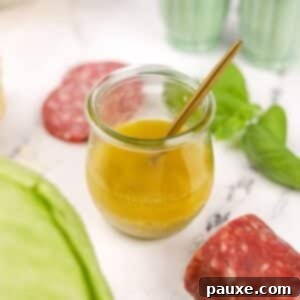
Leon Salad Dressing (Famous La Scala Recipe)
Leon salad dressing, also widely known as La Scala dressing, is a unique and celebrated vinaigrette created by Chef Jean Leon from the iconic La Scala Beverly Hills restaurant. This easy-to-make homemade recipe brings restaurant-quality flavor right to your kitchen.
Course: Condiments, Salad
Cuisine: American, Italian
Prep Time: 5 minutes
Total Time: 5 minutes
Yields: 6 servings
Calories: Approximately 99 kcal per serving
Author: Dorothy Bigelow
Ingredients
Instructions
Combine all listed ingredients—extra virgin olive oil, white wine vinegar, dry mustard powder, salt, black pepper, and finely grated Parmesan cheese—in a small mixing bowl or a glass jar with a secure lid.

Whisk vigorously or shake well (if using a jar) until all ingredients are thoroughly combined and the dressing achieves a smooth, emulsified consistency.

Transfer the dressing into a salad cruet or a pourable container (if you used a bowl) for easy serving and storage.

Serve immediately over your favorite salad or dish, or set aside in the refrigerator.
Store any remaining dressing in an airtight container in the refrigerator for up to 1-2 weeks. Remember to allow it to rest at room temperature for 10-30 minutes before serving to soften the olive oil. Shake well before each use.
Notes
- Chef Leon’s Signature: Leon Salad Dressing is the signature creation of Chef Jean Leon from the famous La Scala restaurant in Beverly Hills. It is famously paired with their very popular La Scala Chopped Salad.
- Storage and Leftovers: The olive oil will solidify when chilled. To restore it, simply leave the dressing at room temperature for 10-30 minutes, and it should “melt” enough to be shaken and used on your favorite salads.
- Mustard Powder vs. Dijon: The original recipe specifically calls for dry mustard powder, which provides a unique pungency and helps with emulsification. While highly recommended, Dijon mustard can be substituted in a pinch, though it may alter the flavor slightly.
- Vinegar Choices: White wine vinegar provides a subtle, balanced tang. Red wine vinegar can be used for a stronger flavor if preferred. However, strong white vinegar is not recommended as it can be too overpowering.
Nutrition Information (Approximate per 1 tablespoon serving)
- Calories: 99 kcal
- Carbohydrates: 0.3g
- Protein: 2g
- Fat: 10g
- Saturated Fat: 2g
- Polyunsaturated Fat: 1g
- Monounsaturated Fat: 7g
- Cholesterol: 3mg
- Sodium: 261mg
- Potassium: 11mg
- Fiber: 0.1g
- Sugar: 0.1g
- Vitamin A: 34 IU
- Vitamin C: 0.05mg
- Calcium: 51mg
- Iron: 0.2mg
Please note that some of my blog posts here at Dash for Dinner may contain affiliate links. If you make a purchase through these links, I will get a small commission at no additional cost to you. Please see my Disclaimer for more information.

